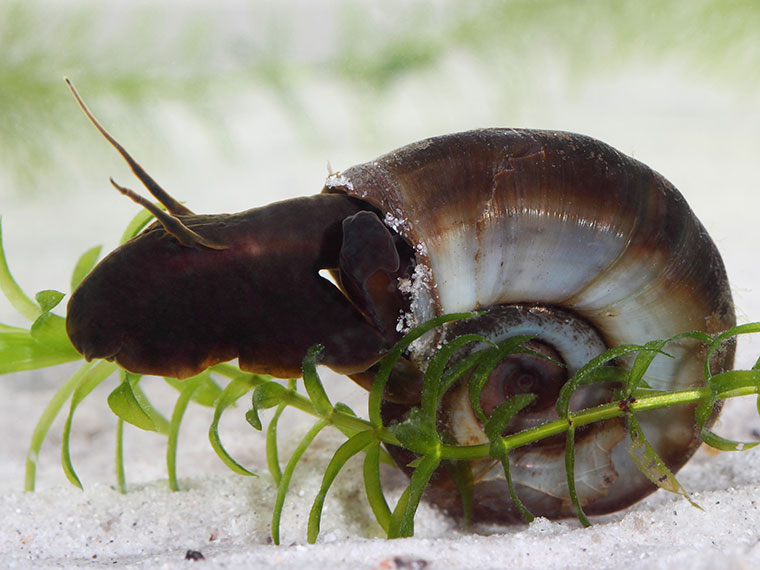The information presented on this page may be dated. It may refer to situations which have changed or people who are no longer affiliated with the university. It is archived as part of Mississippi State University's history.
Mississippi is the top catfish producing state in the country, bringing in over 232 million dollars in production value in 2021. However, in recent decades, significant losses in catfish aquaculture have been associated with the digenetic trematode Bolbophorus damnificus. MAFES and College of Veterinary Medicine scientists in the Thad Cochran National Warmwater Aquaculture Center have shown outbreaks of the trematode on catfish farms result in heavy production and economic losses due to parasite-induced morbidity and mortality.
The parasite life cycle involves the American White Pelican, pond snails, and catfish. Pelicans feed on a large variety of prey species, with many of those species serving as intermediate hosts of trematodes. The trematode enters the pelican and resides in its body and the pelican releases the eggs of the parasite through feces. The newly hatched eggs infect various snail species, such as the Ramshorn snail, who then pass the parasite onto catfish. The team recognized this as a serious threat to the catfish industry in Mississippi and began working to create applicable solutions to this problem.
"We became aware of this particular trematode as an emerging pathogen that was causing catfish production issues," said Dr. David Wise, MAFES research professor and coordinator of the Thad Cochran National Warmwater Aquaculture Center. "Later it became obvious that this led to farm closures and made a huge impact on economic returns."
The problem is not new, scientists have been working on it for over two decades. During the summer of 1999, Wise formed a surveillance team to examine producer farms. The team surveyed an average of sixty ponds daily and ended the summer with a total of over 900 ponds surveyed. Of these ponds, almost forty percent were infected with trematodes. The research team then identified several risk factors that predispose ponds to trematode invasions such as the location of the pond and frequent pelican activity.
"As a farmers' risk factors increase, you need to increase management input to identify ponds which need to be treated," Wise said. "This means looking for evidence of trematodes, which present as a bump under the skin of catfish and then targeting those ponds."
After identifying the trematode problem and potential risk factors for producers, the next step was to develop management solutions to avoid infectious spread. To stop the catfish from becoming diseased, the life cycle of the trematode must be broken.
"Snails were identified as the target of control," said Dr. Matt Griffin, research professor in the College of Veterinary Medicine. "We looked at various chemotherapeutic solutions to eradicate the snails including hydrated lime and copper sulfate."
Researchers explored both methods to optimize these molluscicides-destroying of mollusks such as snails. The hydrated lime method for snail eradication consists of placing the chemical along the pond banks. Hydrated lime is toxic to snails but requires direct contact with the snail to be effective.
For the copper sulfate treatment, Dr. Chuck Mischke, a MAFES research professor with specialized knowledge on aquaculture and toxicology, developed a solution that is harmful to snails and safe for the catfish. His initial research involved administering shoreline treatments of chemicals with a short exposure duration and a highly toxic dosage. Results from this showed copper sulfate was highly effective and the optimal chemical for molluscicide. As the project progressed, Mischke pivoted from shoreline treatment to distributing the chemical directly into the pond.
"The dose we were administering was also close to a deadly dose for the catfish," Mischke said. "The copper can directly kill catfish, but it can also kill the phytoplankton bloom, which produces oxygen for the pond. If the phytoplankton bloom is killed, you might lose fish because of the low amount of oxygen."
The hydrated lime and copper sulfate management solutions are applied case by case depending on the level of parasites in the pond. At the start of a mild outbreak, hydrated lime is a safer option to slow the spread and control the snail population. A trematode diagnosis in catfish, although harmful, is not a death sentence.
"Once the cyst develops, it is walled off by host tissue and doesn't affect the host anymore," said Wise. "We've had fish completely covered in trematode bumps. Once they were removed from continuous trematode infection, the fish resumed feeding, had a high disease resistance, and a normal growth performance. If we can stop new infections, the fish recover."
If the infection is not too severe and the fish are still able to eat, hydrated lime will keep the disease outbreak from growing while keeping the fish safe. If a trematode outbreak occurs on a large scale, then copper sulfate proves the better option.
As the research continues, the team is working to refine their methods to optimize molluscicide. Through a collaborative effort with the University of Mississippi's National Center for Natural Products Research Laboratory, a molecular assay is being developed to detect snail DNA in ponds.
"This will help us evaluate whether or not a pond needs to be treated for trematode issues or whether or not the trematode treatment was effective," said Wise.
Catfish production is a vital source of income for many Mississippians and without the work of the Thad Cochran National Warmwater Aquaculture Center, the state's economy and the lives of catfish producers would be negatively affected. While continuing this research to refine their molluscicide methods, Wise, Griffin, and Mischke and their team are dedicated to finding a proactive strategy to prevent trematode infections and maximize profitability and sustainability of Mississippi catfish aquaculture.
This research is funded by Mississippi Agricultural and Forestry Experiment Station and the United States Department of Agriculture's Agricultural Research Service. In addition to Wise, Mischke, and Griffin, the research team includes Dr. Wes Lowe, assistant professor and MAFES scientist in agricultural and biological engineering; Dr. Graham Rosser, assistant research professor with the MSU College of Veterinary Medicine; Dr. Geoff Waldbieser, research molecular biologist at the United States Department of Agriculture's Agricultural Research Service; and Dr. Bradley Richardson, research fish biologist at the United States Department of Agriculture's Agricultural Research Service. Research collaborators with the University of Mississippi National Center for Natural Products Research include Drs. Junaid Ur Rehman, Mohammad Ashfaq, Dhammika Nanayakkara, and Ikhlas Khan. Additional collaborators include Dr. Ben Beck, aquatic animal health research physiologist with the United States Department of Agriculture's Agricultural Research Service and Dr. Alvin Camus of the University of Georgia.
We became aware of this particular trematode as an emerging pathogen that was causing catfish production issues. Later it became obvious that this led to farm closures and made a huge impact on economic returns.
Dr. David Wise
Behind the Science

Chuck Mischke
Research Professor
Education: B.S., Fisheries Management, Mississippi State University; M.S., Ph.D., Fisheries Biology, Iowa State University
Years At MSU: 21
Focus: Catfish fry pond preparation including fertilization and zooplankton management, toxicity screening for potential chemicals used in aquaculture
Passion At Work: My passion at work is to provide solutions to the most pressing problems of the U.S. catfish aquaculture industry.

Matt Griffin
Research Professor
Education: B.S., Biology, University of Wisconsin La Crosse; Ph.D., Veterinary Medical Science, Mississippi State University
Years At MSU: 17
Focus: Aquatic animal health management
Passion At Work: My primary focus is to ensure the profitability and sustainability of Mississippi catfish producers through effective and cost efficient disease management and production practices.

David Wise
Research Professor and Coordinator
Education: B.S., Aquatic Biology, Texas State University; M.S., Aquaculture, Ph.D., Microbiology, Clemson University
Years At MSU: 28
Focus: Research, extension, and diagnostic services with an emphasis on fish health management, profitability for farmers, and production efficiencies
Passion At Work: I am passionate about conducting research that has direct industry application and using this information to develop farm-specific management strategies to increase farm


